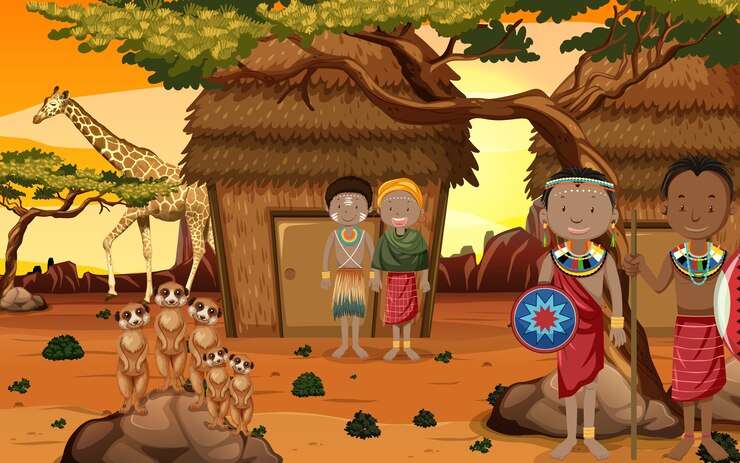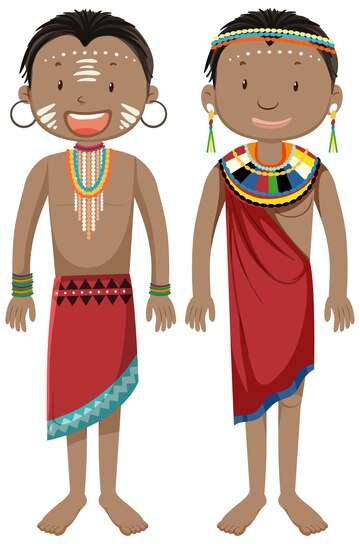TABLE OF CONTENT
ToggleTribes
Hey Mumbai University SYBA IDOL students! Today, we’re diving into the fascinating world of Human Geography , continue exploring the chapter – “Tribes“. Tribes are unique communities with distinct cultural, social, and economic practices.
Understanding tribes helps us appreciate the diversity of human societies and the various ways people live around the world.
First, we will define what tribes are. Tribes are groups of people who live together, often in isolated areas, and share common ancestry, language, culture, and traditions.
Next, we will look at the general features of tribes. This includes their social structures, ways of living, economic activities, and how they interact with their environment.
We will then write short notes on three specific tribes:
- Eskimo: Indigenous people living in the Arctic regions, known for their unique adaptations to the cold environment.
- Bedouin: Nomadic tribes from the desert regions of the Middle East, known for their distinctive way of life and strong cultural traditions.
- Masai: Indigenous people from East Africa, particularly Kenya and Tanzania, known for their cattle-herding and vibrant cultural practices.
Finally, we will discuss the position of women in Bedouin society. This will help us understand gender roles and how cultural practices influence the status and responsibilities of women within these communities.
By the end of this lesson, you’ll have a comprehensive understanding of tribes, their characteristics, and the unique aspects of the Eskimo, Bedouin, and Masai tribes.
So, SYBA IDOL Mumbai University students, get ready to unwrap the mysteries of “Tribes” with customized IDOL notes just for you. Let’s jump into this exploration together.


True and false:-
a. The tribes cannot compete with modern organisations, such as state – True
b. The Ainu tribes are the racial stock of southern Nigeria – False
c. Basseri is a native tribe of Iran – True
d. Eskimos are among the oldest population of Africa whose average height is unusually short – False
e. Eskimo groups have uniformity in languages, physical type and culture in spite of their regional differences – True
Fill in the blanks :-
- Cultivation of plants are the mainstay of tribal groups .
- Barter and redistribution of surplus products are one of the chief characteristics of tribal community .
- Dani are tribal inhabitants of New Guinea.
- The Negros of Central and Southern Africa are known as Bantu.
- The Eskimos have adapted themselves to an extremely cold and ice-covered environment in the Arctic region .
Multiple choice question:-
a) Eskimo people hunted seals with
i. harpoons
ii. bow and arrow
iii. spears
ANS- i. harpoons
b) The highest point of Sami’s land is
i. Kebnekajse at 2121 metres
ii. Mt. Everest 8848 metres
iii. Ladakh
ANS- i. Kebnekajse at 2121 metres
c) According to their own oral history the Masai originated from the
i. Lower Ganga valley
ii. Upper Brahmaputra valley
iii. lower Nile valley
ANS- i. Lower Ganga valley
d) Masai can be recognised by the special red cloth they wear known as
i. Skirt
ii. Shuka
iii. Shorts
ANS- ii. Shuka
Short answer question:-
Question 1:- Define tribes
A tribe can be defined as an aggregate of people linked together by means of social ties, a common language, and the recognition of a common cultural heritage. Tribes are typically characterized by their unique customs, beliefs, and social structures, and they often have a low level of technological development and productivity per capita. The term “tribe” refers to a cultural or social group rather than a biological or racial one, and tribal communities often engage in activities such as plant cultivation, animal domestication, and barter for the exchange of goods
Question 2 :- What are the general features of tribes?
Introduction:
Tribes are unique communities with distinct characteristics that set them apart from other groups in society. Understanding these features helps in appreciating the diversity and richness of human cultures. Tribes are often characterized by their social ties, common language, cultural heritage, and economic activities. This answer will explore the general features of tribes in detail.
1. Social Ties
- Definition: Tribes consist of groups of people who are closely linked by social relationships.
- Example: These connections are often through extended family ties, making family a central part of tribal life.
2. Common Language
- Definition: Members of a tribe usually share a common language.
- Example: This shared language is a key aspect of their cultural identity and helps in maintaining unity within the tribe.
3. Cultural Heritage
- Definition: Tribes maintain a common cultural heritage, which includes customs, beliefs, rituals, and traditions.
- Example: This cultural heritage is passed down through generations and is central to the tribe’s identity.
4. Low Technological Development
- Definition: Most tribal communities have a low level of technological advancement.
- Example: This affects their productivity and the types of economic activities they engage in, such as traditional farming or hunting and gathering.
5. Economic Activities
- Definition: The primary economic activities of tribes often include the cultivation of plants and animal domestication.
- Example: Many tribes also engage in hunting and gathering to meet their food needs.
6. Semi-Nomadic Lifestyle
- Definition: Some tribes lead a semi-nomadic lifestyle, moving periodically in search of resources.
- Example: This movement can be influenced by the seasons or the availability of food and water.
7. Barter System
- Definition: Tribes typically rely on barter and the redistribution of surplus products as their main means of economic exchange.
- Example: Goods and services are exchanged without using money, promoting a system of mutual support within the tribe.
8. Isolation
- Definition: Many tribes are isolated from modern political organizations and may inhabit less hospitable environments.
- Example: This isolation can widen the cultural and technological gaps between tribes and the rest of the population.
Conclusion:
Tribes are unique communities with distinct social ties, common language, cultural heritage, and specific economic activities. Their low technological development, semi-nomadic lifestyle, barter system, and isolation further define their way of life. Understanding these features is essential to appreciating the diversity and richness of human cultures. Tribes represent a vital part of human history and cultural heritage, contributing to the global mosaic of human societies.
Question 3 :- State how is a woman’s position in the Bedouin society
Introduction:
Bedouin society, known for its nomadic lifestyle, has a rich cultural heritage. Women in Bedouin communities play crucial roles that are vital to both the household and the economy. This answer will explore the various responsibilities of Bedouin women and highlight their importance despite the patriarchal nature of their society.
Roles and Responsibilities of Bedouin Women:
- Child Rearing
- Definition: Bedouin women are primarily responsible for raising children.
- Example: They ensure that children are educated and socialized according to the cultural norms of the tribe.
- Animal Husbandry
- Definition: Women actively participate in herding and milking livestock.
- Example: This work is crucial for the family’s food supply and economic stability.
- Household Management
- Definition: Managing the household is a significant responsibility of Bedouin women.
- Example: They handle tasks like cooking, cleaning, and maintaining the tent or dwelling.
- Craftsmanship
- Definition: Bedouin women are skilled in weaving and making clothing.
- Example: They create the tents that serve as their homes and craft items that reflect the family’s wealth and status.
- Cultural Transmission
- Definition: Women play a key role in preserving and passing down cultural traditions.
- Example: They teach stories, practices, and cultural norms to the next generation.
The Patriarchal Structure and Women’s Status:
- Leadership Roles
- Definition: Despite their significant contributions, leadership roles in Bedouin society are typically held by men.
- Example: Men make most of the major decisions within the family and tribe.
2. Respect and Recognition
- Definition: Bedouin women are respected for their roles and seen as the backbone of the family unit.
- Example: Their position can vary depending on the specific tribe and the degree of modernization affecting their lifestyle.
Conclusion:
Bedouin women hold vital roles in their communities, contributing significantly to child rearing, animal husbandry, household management, craftsmanship, and cultural transmission. Despite living in a patriarchal society where men hold most leadership positions, women are respected and recognized for their essential contributions. Their roles ensure the smooth functioning and cultural preservation of Bedouin society, making them indispensable members of their communities. Understanding the multifaceted roles of Bedouin women highlights the importance of their work and the respect they garner within their cultural framework.
Short note on:-
Question 1 :- Eskimo
Introduction:
The Eskimo, also known as the Inuit or Yupik, are indigenous peoples living in the Arctic regions of Canada, Greenland, and Alaska. They have adapted to extremely cold and icy environments where agriculture is not possible. Their way of life revolves around hunting and fishing. This answer will explore the lifestyle, economy, social structure, and culture of the Eskimo people.
1. Harsh Arctic Environment
- Definition: The Eskimo have adapted to living in very cold and snow-covered areas.
- Example: Due to the vast icebound areas, farming is not feasible, and they rely on other means for survival.
2. Economic Activities
- Definition: Their economy is based on hunting and fishing.
- Example: The main food sources are caribou, seals, walrus, and whale meat. They use tools like harpoons, bows and arrows, and fish spears for hunting.
3. Housing
- Definition: The Eskimo have different types of homes for winter and summer.
- Example: In winter, they live in igloos made of ice blocks. In summer, they use tents made of animal skins.
4. Clothing
- Definition: Their clothing is made to protect against the harsh Arctic climate.
- Example: They wear clothes made from caribou furs and hides, which provide warmth and protection.
5. Social Structure
- Definition: The Eskimo community is centered around the nuclear family.
- Example: Families are closely-knit, and their social life is built around family bonds.
6. Cultural Beliefs
- Definition: The Eskimo have a deep connection to nature and believe in animism.
- Example: They believe that all living and non-living things have spirits and maintain a rich tradition of storytelling and oral history.
7. Language and Uniformity
- Definition: Despite regional differences, the Eskimo share a common language and culture.
- Example: They speak dialects of the Eskimo-Aleut language family, which unites them culturally.
Conclusion:
The Eskimo are indigenous peoples who have adapted to living in the harsh Arctic regions. Their economy is based on hunting and fishing, with a strong dependence on natural resources. They live in igloos during the winter and tents in the summer, wearing protective clothing made from animal skins. The Eskimo community is family-centered, with a deep connection to nature and strong cultural traditions. Despite the regional differences, they share a common language and culture, making them a unique and resilient group of people. Understanding their way of life provides insight into how humans can adapt to extreme environments while maintaining a rich cultural heritage.
Question 2 :- Bedouin
Introduction:
The Bedouin are a group of Arab nomadic peoples who live in the deserts of North Africa and the Middle East. The name “Bedouin” comes from the Arabic word “bedu,” meaning “desert dwellers.” They are descendants of tribes that traditionally roamed the Arabian and Syrian deserts. This answer will explore their society, lifestyle, culture, and the challenges they face today.
1. Society and Structure
- Definition: Bedouin society is organized into tribes.
- Example: The tribe is led by a head known as the sheikh, who is assisted by a council of male elders. This structure is patriarchal, meaning it is dominated by men.
2. Livelihood and Migration
- Definition: Bedouins primarily rely on animal herding for their livelihood.
- Example: They raise livestock such as camels, sheep, and goats. They move seasonally, migrating to cultivated lands during dry summers and into the desert during rainy winters.
3. Traditional Tents
- Definition: Bedouins live in tents that are well-suited for desert life.
- Example: Their black tents are made from goat hair, providing shelter from the harsh desert environment.
- Hospitality and Generosity
- Definition: Bedouins are known for their warm hospitality and generosity.
- Example: They often welcome guests with food and drink, showing their kindness and respect for visitors.
- Rich Oral Traditions
- Definition: Bedouin culture is rich in oral traditions.
- Example: Their culture includes poetry, music, and storytelling, reflecting their deep connection to the desert landscape.
- Modernization and Change
- Definition: Bedouins face challenges due to modernization and changing land use.
- Example: Many Bedouins are struggling to maintain their traditional lifestyles. However, efforts are being made to preserve their cultural heritage while adapting to contemporary needs.
Conclusion:
The Bedouin are a group of Arab nomadic peoples living in the deserts of North Africa and the Middle East. Their society is organized into tribes led by a sheikh. They rely on animal herding and migrate seasonally. They live in traditional black tents and are known for their hospitality and rich oral traditions. Despite the challenges posed by modernization, efforts are being made to preserve their cultural heritage. Understanding the Bedouin way of life provides insight into how they have adapted to the harsh desert environment while maintaining a rich and unique culture.
Question 3 :- Masai
Introduction:
The Masai, also spelled Maasai, are a Nilotic ethnic group known for their unique customs, dress, and strong cultural identity. They primarily live in southern Kenya and northern Tanzania. This answer will explore their lifestyle, social structure, culture, and the challenges they face today.
- Semi-Nomadic Pastoralists
- Definition: The Masai are semi-nomadic, moving with their cattle to find fresh grazing land.
- Example: Their cattle are central to their economy, providing food like milk and meat, and serving as a measure of wealth and status.
- Distinctive Dress and Jewelry
- Definition: The Masai are known for their colorful dress and intricate jewelry.
- Example: They wear a red shuka (a type of cloth) and create beautiful jewelry that is an important part of their cultural identity.
- Patriarchal Society
- Definition: Masai society is led by elder men who make major decisions.
- Example: The elders are highly respected and their decisions are followed by the community.
- Language and Education
- Definition: The Masai speak the Maa language but are also educated in Swahili and English.
- Example: Swahili and English are the official languages of Kenya and Tanzania, and many Masai children learn these languages in school.
- Monotheistic Religion
- Definition: The Masai worship a single deity known as Enkai or Engai.
- Example: While many Masai have adopted Christianity and Islam, their traditional belief in Enkai remains strong.
- Facing Modern Challenges
- Definition: The Masai face challenges such as land encroachment, climate change, and modernization.
- Example: These challenges impact their traditional way of life, but there are initiatives to help them balance preserving their culture with meeting modern needs.
Conclusion:
The Masai are a Nilotic ethnic group living in southern Kenya and northern Tanzania. Their semi-nomadic lifestyle revolves around their cattle, which are central to their economy and social structure. They are known for their distinctive dress and jewelry, and their society is patriarchal. The Masai speak the Maa language and are also educated in Swahili and English. They worship a single deity, Enkai, although many have adopted other religions. The Masai face challenges due to modernization and environmental changes, but efforts are being made to help them preserve their cultural heritage while adapting to contemporary needs. Understanding the Masai way of life provides insight into their rich culture and the resilience they show in the face of modern challenges.
Important Note for Students :– Hey everyone! All the questions in this chapter are super important
